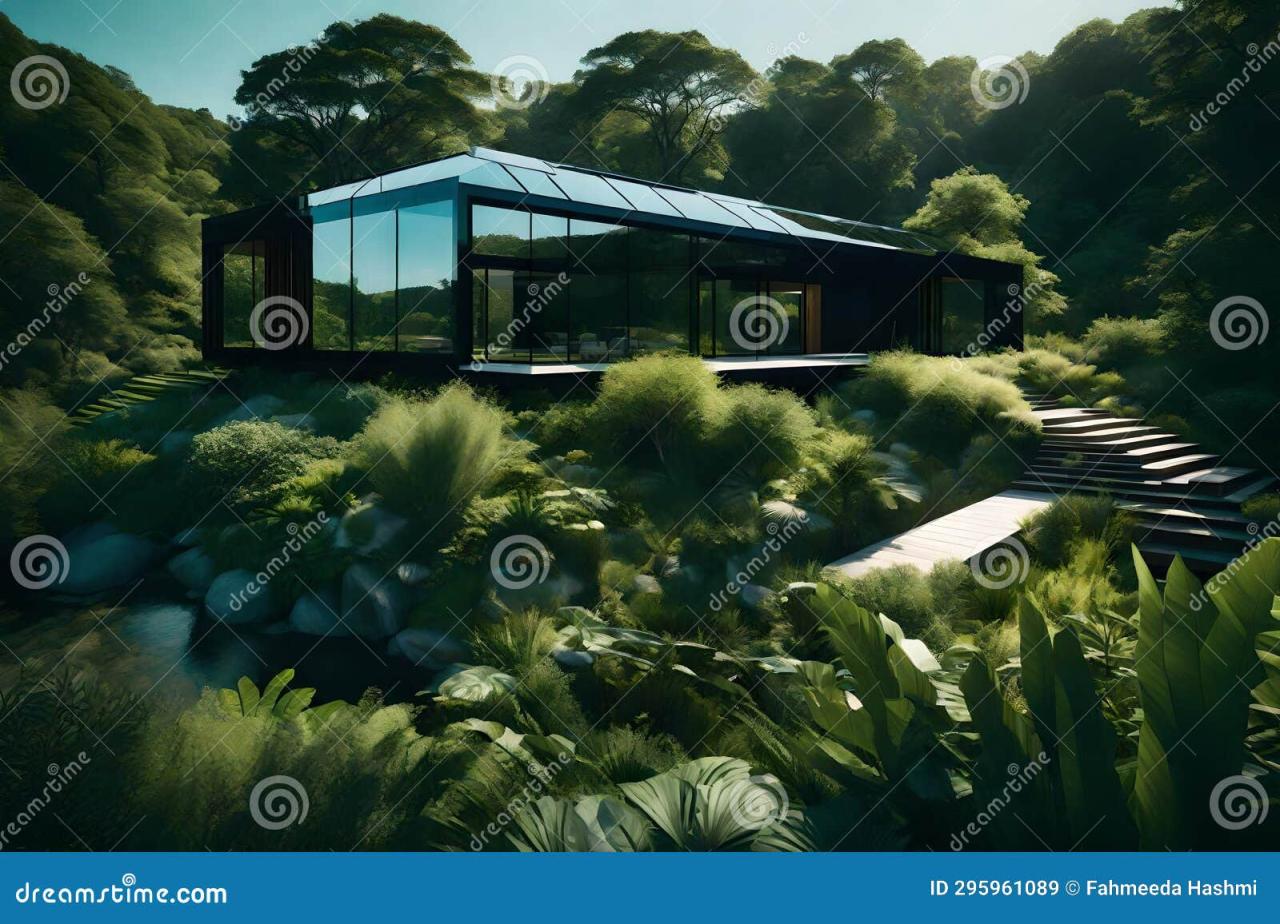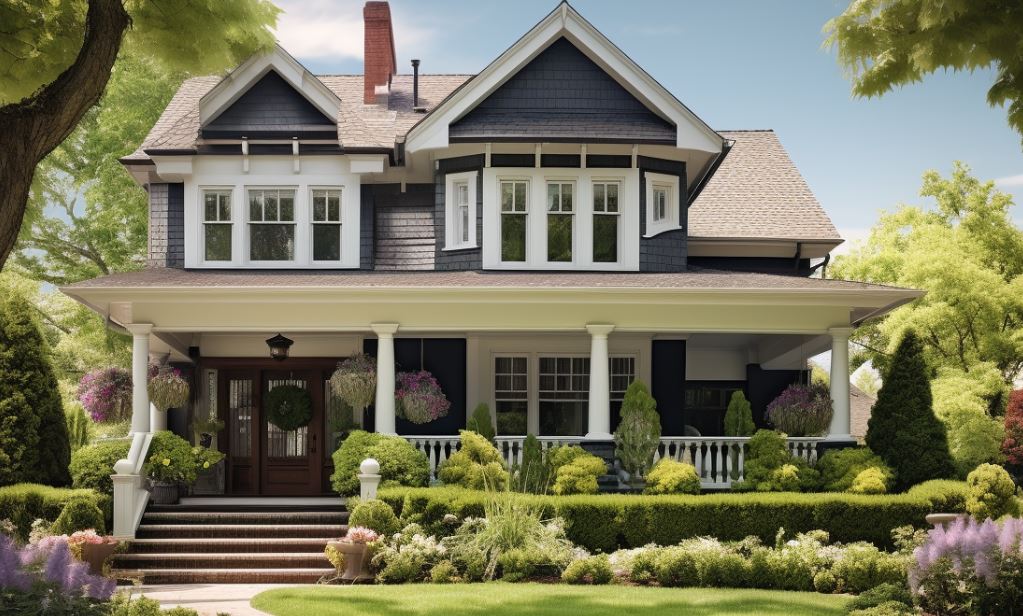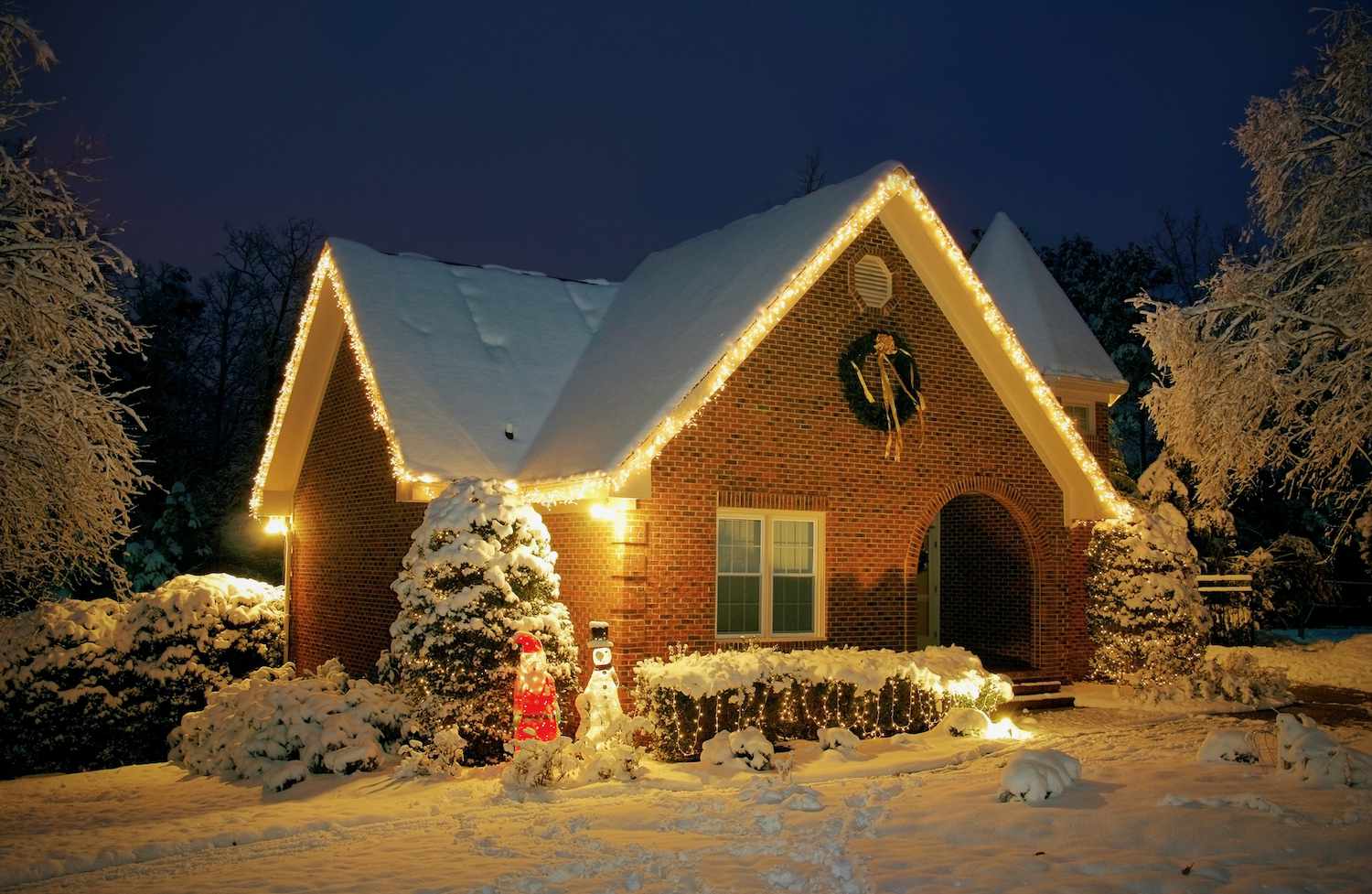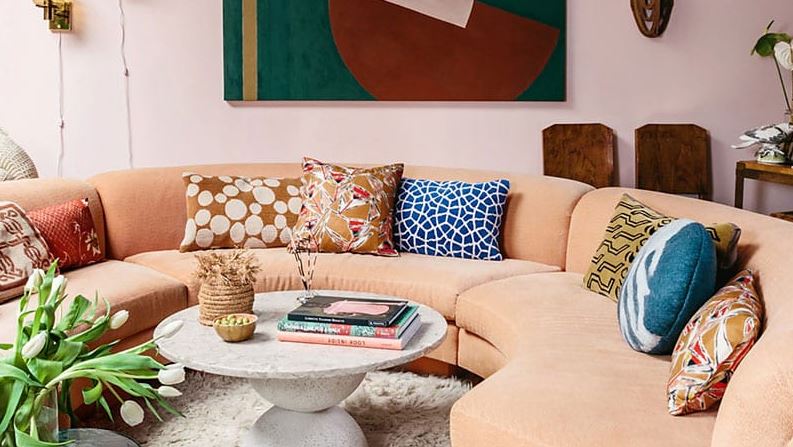Modern loft house designs offer a unique blend of open space and stylish aesthetics. Imagine a home that seamlessly combines functionality with a modern aesthetic, perfect for those who crave both comfort and contemporary living. This guide delves into everything from architectural details and interior design to the practicality of living in such a space, exploring the advantages, disadvantages, and essential considerations.
From the unique architectural characteristics and design elements that set it apart, to the considerations of floor plans and sustainable materials, this exploration of modern loft houses promises to be an insightful and comprehensive overview. The discussion also encompasses the nuances of interior design, functionality, and the integration of modern technology, all in a clear and concise manner.
Defining Modern Loft Houses
Modern loft houses are a popular choice for those seeking a blend of open space, functionality, and a contemporary aesthetic. They often feature high ceilings, large windows, and an open floor plan, creating a bright and airy atmosphere. These homes are more than just a structure; they’re a reflection of a lifestyle that values both practicality and style.Modern loft houses are characterized by a unique architectural style that distinguishes them from traditional homes.
Key elements like exposed structural features, clean lines, and a focus on natural light define the modern loft aesthetic. They often prioritize efficient use of space and integration of technology.
Architectural Characteristics
Modern loft houses are typically designed with a focus on maximizing natural light and space. High ceilings, often soaring above 10 feet, create a sense of grandeur and openness. Large windows, often spanning multiple walls, allow abundant sunlight to flood the interior, making the space feel airy and inviting. Exposed structural elements, like beams and pipes, are frequently embraced rather than hidden, showcasing the building’s raw beauty and industrial heritage.
Clean lines and geometric shapes are prevalent in the design, emphasizing simplicity and modern aesthetics. These features contrast with the often more ornate and detailed elements found in traditional homes.
Design Elements Distinguishing Modern Lofts
Key design elements that differentiate modern loft houses from other styles include the use of contemporary materials, such as polished concrete, steel, and glass. These materials are often incorporated into the structural elements, exposed walls, and finishes, creating a sleek and minimalist feel. Minimalist interior design is common, with furniture and décor selected for their practicality and aesthetic value.
Another crucial aspect is the integration of modern technology, such as smart home systems, efficient appliances, and high-quality lighting, often seamlessly incorporated into the design. This seamless integration of technology into the home’s aesthetic is a hallmark of modern loft houses.
Comparison with Traditional Lofts
Traditional lofts, often situated in older buildings, frequently feature lower ceilings, less natural light, and more ornate details. Modern lofts, on the other hand, emphasize clean lines, high ceilings, and abundant natural light. The materials used in construction and finishes are also vastly different. Modern lofts typically utilize contemporary materials, while traditional lofts might incorporate wood, brick, and other more traditional building materials.
While both types of lofts often feature an open floor plan, modern lofts tend to have a more minimalist, industrial-inspired feel.
Construction Materials
Common materials in modern loft house construction include steel, concrete, and glass. Steel is frequently used for structural support and framing, providing strength and stability. Concrete, in various forms like polished or exposed finishes, is often used for flooring and walls, offering a durable and modern aesthetic. Large expanses of glass are used to maximize natural light and create visual connections to the outdoors.
Other materials, like reclaimed wood and polished metals, might be incorporated for accents and specific design features. The use of sustainable materials is becoming increasingly prevalent, with designers seeking environmentally friendly choices.
Floor Plans and Layouts, Modern loft house
Modern loft house floor plans typically prioritize open layouts. The absence of interior walls often creates a spacious, multi-functional area. The kitchen, living area, and dining area might blend seamlessly, fostering a sense of spaciousness and connectivity. Bedrooms are often separated from the main living area by partitions or strategically placed furniture, maintaining privacy while preserving the open concept.
Balconies or rooftop terraces are common additions, maximizing outdoor space and providing views. These designs reflect the modern lifestyle’s emphasis on flexibility and adaptability.
Interior Design Concepts
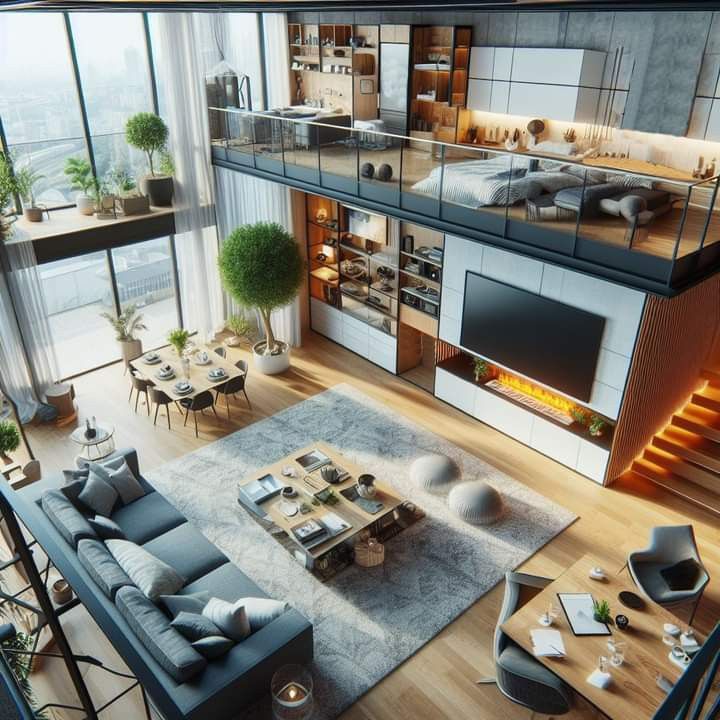
Source: pinimg.com
Modern loft houses offer a unique blend of open space and personalized design. The inherent flexibility of loft layouts allows for innovative approaches to interior design, balancing aesthetic appeal with practical functionality. This adaptability is key to creating spaces that are both stylish and highly livable.Interior design in modern loft houses prioritizes maximizing natural light, creating a seamless flow between different areas, and selecting furniture that enhances both the space and the lifestyle of the inhabitants.
Modern loft houses are all about open spaces and industrial vibes. But if you’re looking for something with a similar airy feel but closer to the water, check out a modern beach house like the ones at Modern beach house. They often feature large windows, natural materials, and plenty of light, which is something loft houses also tend to excel at, bringing the outdoors in.
These design choices are not just about aesthetics; they are about optimizing the overall experience of living in the loft.
Open-Concept Living Spaces
Open-concept layouts are central to modern loft design. This approach seamlessly integrates living, dining, and kitchen areas, fostering a sense of spaciousness and connection. Furniture arrangements are crucial in defining zones within the open space without sacrificing the overall flow. For instance, strategically placed area rugs can visually separate dining and living areas, while high ceilings and large windows amplify the sense of space.
Furniture and Decor Selection
Choosing furniture and decor for a modern loft house involves a delicate balance between practicality and style. Prioritize pieces that are both visually appealing and functional. Multi-functional furniture, like ottomans with storage or coffee tables with integrated drawers, is ideal for maximizing space and minimizing clutter. Consider using modular furniture to adapt to future needs and preferences.
Neutral color palettes, such as greys, creams, and beiges, create a backdrop for showcasing vibrant artwork and accessories. Incorporating textures like wood, metal, and leather adds depth and visual interest.
Lighting Strategies
Lighting plays a critical role in creating a warm and inviting atmosphere in a modern loft house. Maximize natural light by incorporating large windows and skylights, and use sheer curtains or blinds to diffuse sunlight. Layered lighting is essential. Ambient lighting, such as recessed lighting or pendant lights, provides general illumination. Task lighting, such as desk lamps or reading lights, focuses light on specific areas.
Accent lighting, such as spotlights or wall sconces, highlights architectural features and artwork.
Creating a Cozy Atmosphere
A modern loft house, despite its open design, can be made cozy and inviting. Incorporate soft textiles, such as throws, blankets, and rugs, to add warmth and texture. Plants and natural elements, such as wood accents or stone features, can bring the outdoors in. Artwork and personal touches, like family photos or cherished objects, personalize the space and add warmth.
Careful selection of lighting, as mentioned previously, can greatly impact the mood and ambiance.
Color Palettes
A well-chosen color palette is key to creating the desired ambiance in a modern loft house.
- Neutral Palette: A palette using greys, creams, whites, and beiges creates a sophisticated and calming atmosphere, which is a popular choice for modern loft spaces. It’s versatile and allows for easy incorporation of bolder accents.
- Earthy Tones: Incorporating warm browns, terracotta, and deep greens creates a cozy and grounding feel, drawing inspiration from nature. This palette brings a sense of tranquility and connection to the outdoors.
- Modern Monochromatic: Using different shades of a single color, such as varying tones of grey or blue, creates a sleek and sophisticated aesthetic. This approach is particularly effective in maximizing the sense of spaciousness in a loft.
- Bold Accents: Introduce pops of color through artwork, accessories, or furniture. A vibrant accent wall or patterned rug can add personality without overwhelming the space.
Functionality and Lifestyle
Modern loft houses offer a unique blend of spaciousness and practicality, but also come with their own set of considerations. Their open layouts and high ceilings create a sense of grandeur and freedom, but this very design can sometimes present challenges for those seeking a more traditional living experience. Understanding the advantages, disadvantages, and suitability for various lifestyles is crucial for potential buyers.Living in a modern loft house can be incredibly rewarding, offering a dynamic and adaptable space.
However, it’s important to acknowledge the potential downsides and ensure the lifestyle aligns with the unique features of the home. This includes carefully considering the maintenance requirements and the potential challenges that may arise from the unusual layout.
Advantages of Modern Loft Houses
Modern loft houses typically feature large, open spaces that encourage social interaction and create a sense of openness and spaciousness. This design often leads to an airy and light-filled interior, enhancing the overall living experience. The flexibility of these layouts also allows for easy adaptation to changing needs and preferences over time. This adaptability is a significant advantage.
Disadvantages of Modern Loft Houses
The open layout of loft houses, while attractive, can sometimes feel less private compared to more traditional homes. This can be a significant disadvantage for those who value individual space. The high ceilings, while creating a sense of grandeur, can also lead to higher energy bills, depending on the insulation and heating/cooling systems. This is an important factor to consider when assessing the total cost of ownership.
Suitability for Different Lifestyles
The versatility of loft houses makes them suitable for various lifestyles. Young professionals seeking a modern and efficient living space often find loft houses appealing. Families with children might find the adaptable layout beneficial, although careful consideration of space allocation and noise levels is necessary. Couples looking for a stylish and spacious home might also find loft living ideal.
Modern loft houses often feature a clean aesthetic, prioritizing open spaces and minimalist design. This style is closely related to the concept of a “Clean aesthetic house,” which emphasizes simplicity and functionality. Think sleek lines, natural light, and neutral color palettes; these elements are key to creating a modern loft house that feels both spacious and inviting. Clean aesthetic house principles often translate directly to this type of home design.
Maintenance Requirements
Modern loft houses often require specialized maintenance due to their unique design. Regular cleaning of high-reaching areas and ensuring proper ventilation in the open spaces are crucial. Maintenance needs might differ significantly from those of a traditional home. The open concept might also make cleaning more time-consuming.
Comparison with Other House Types
Modern loft houses differ from traditional houses in terms of maintenance requirements and energy efficiency. Traditional houses might have more defined maintenance schedules, whereas loft houses often require more attention to ventilation and potential drafts. The high ceilings and open layouts in loft houses can also affect energy consumption. This requires careful consideration of insulation and HVAC systems.
Potential Challenges of Modern Loft House Living
The unique layout of loft houses can present certain challenges. Storage solutions might need to be carefully considered to accommodate the need for ample storage. Also, noise levels can be an issue, particularly in open-plan layouts, which need careful consideration for family life.
Modern loft houses are all about open spaces and a sleek aesthetic, but they often draw inspiration from urban modern home designs. Think of the spacious layouts and minimalist details found in a place like Urban modern home , and you’ll see the similarities. Ultimately, the modern loft house style manages to combine the best of both worlds, creating a unique and functional living space.
Integration of Modern Technology
Smart home technology can be effectively integrated into the design of modern loft houses. Integrated lighting systems, automated blinds, and smart thermostats can significantly enhance comfort and energy efficiency. These features can enhance convenience and contribute to a more sophisticated living experience.
Space Optimization and Layout
Modern loft houses offer a unique opportunity to maximize living space and create a functional and stylish home. Clever design choices are crucial for making the most of these open floor plans. Careful consideration of storage, light, and ventilation can transform a large space into a warm and inviting home.Optimizing a loft’s layout is about more than just fitting furniture; it’s about crafting a space that reflects the lifestyle of its inhabitants.
This involves strategic use of every inch, maximizing natural light, and seamlessly integrating storage solutions into the design.
Strategies for Maximizing Space
Careful planning is key to optimizing space in a loft. Creating a sense of order and minimizing clutter are crucial for maximizing the perceived spaciousness.
- Multi-functional Furniture: Consider pieces that serve multiple purposes. A sofa bed can accommodate guests while saving floor space. Storage ottomans can provide seating and storage simultaneously.
- Vertical Space Utilization: Tall bookshelves, floating shelves, and wall-mounted cabinets maximize vertical space for storage without sacrificing floor area. This creates a visually appealing and organized look.
- Open Floor Plans: The loft’s inherent open layout can be maximized by strategic placement of furniture and room dividers. This allows for a sense of spaciousness and flexibility.
- Decluttering and Organization: A consistent decluttering strategy is essential. Using storage solutions, like bins and containers, helps to keep the loft organized and maintain its airy feel.
Incorporating Storage Solutions
Storage solutions should be seamlessly integrated into the design to maintain the loft’s aesthetic. Choosing the right storage system can significantly impact the overall functionality and organization of the space.
- Built-in Storage: Built-in cabinets and shelving units are excellent for maximizing storage space. They can be customized to match the loft’s unique features and aesthetic. This is particularly important in lofts with unique architectural elements.
- Modular Systems: Modular storage systems offer flexibility and adaptability to changing needs. They are often customizable in terms of size, color, and design, which makes them a great choice for modern loft homes.
- Creative Storage Solutions: Using under-stair storage, recessed shelving, or hidden storage solutions adds an extra touch of elegance and functionality.
- Storage in Design: Integrating storage directly into furniture, such as ottomans with storage or coffee tables with hidden compartments, maximizes functionality while maintaining the loft’s aesthetic.
Creative Space-Saving Solutions
Clever solutions are vital for optimizing a loft’s space while maintaining its modern aesthetic. Examples of space-saving strategies can transform a loft from a simple open area to a functional and inviting living space.
- Loft Beds: Loft beds free up valuable floor space, allowing for other activities or a home office below. They can also double as a stylish design feature, particularly when combined with built-in storage underneath.
- Multi-Level Layouts: Utilizing different levels in a loft design can create distinct areas for various purposes, while also maximizing vertical space and providing a visually engaging experience.
- Hidden Storage: Using hidden storage compartments or sliding doors for storage solutions helps to maintain a clean and uncluttered look, without sacrificing space for storage.
Creating a Multi-Functional Layout
A multi-functional layout is key to maximizing the versatility of a modern loft. This allows the homeowner to effectively use the space for multiple purposes.
- Flexible Zones: Create zones for different activities, such as a workspace, a dining area, or a relaxation zone. Room dividers, rugs, and different lighting schemes can help define these zones.
- Adaptable Spaces: Consider spaces that can easily transition between functions. A room that can be a home office during the day can easily become a guest room at night.
Importance of Natural Light and Ventilation
Maximizing natural light and ventilation is critical for creating a bright and airy atmosphere in a loft.
- Large Windows: Large windows or skylights bring natural light into the space, making it feel more spacious and inviting.
- Strategic Placement of Furniture: Positioning furniture strategically can maximize natural light throughout the loft.
- Effective Ventilation: Good ventilation is essential to maintain a healthy and comfortable atmosphere. Proper ventilation can reduce the feeling of confinement in a loft.
Sample Floor Plan
This sample floor plan for a modern loft emphasizes efficiency and functionality. It integrates a variety of features, including a multi-functional layout and ample storage solutions. (Note: A visual floor plan is not possible within this text format.)
A hypothetical modern loft floor plan could feature a combined living and dining area. A well-lit kitchen could be centrally located with access to a patio or balcony.
A home office area could be situated with natural light. A bedroom could be separated with a divider or architectural element. Ample storage would be included in the design, strategically placed in areas like the hallway and under the staircase.
Building Materials and Construction: Modern Loft House
Modern loft houses often prioritize both aesthetics and sustainability. This involves careful consideration of materials, construction methods, and energy efficiency to create spaces that are both beautiful and environmentally responsible. Choosing sustainable materials reduces the environmental footprint of the building process, while advanced construction techniques enhance structural integrity and optimize space.Construction materials and methods directly impact a building’s performance, lifespan, and environmental impact.
The use of sustainable materials and energy-efficient design principles is critical in creating modern loft houses that are not only visually appealing but also contribute to a healthier planet.
Modern loft houses are all about open spaces and a cool, minimalist aesthetic. They often prioritize functionality over traditional design. However, a similar concept can be found in modern countryside homes, like the ones featured in this article on Modern countryside home. These homes take the same principles of clean lines and natural light, but adapt them to a rural setting, often incorporating large windows and outdoor spaces.
Ultimately, both styles showcase a desire for modern living, but in different environments. Modern loft houses still reign supreme for urban dwellers seeking a unique living experience.
Sustainable Building Materials
A range of sustainable materials can be used in modern loft house construction. These materials offer environmental benefits and contribute to a healthy indoor environment.
- Recycled and reclaimed materials like reclaimed wood, metal scraps, and concrete aggregate provide a unique aesthetic and minimize the need for new resources.
- Locally sourced materials reduce transportation costs and emissions, contributing to a lower carbon footprint.
- Bamboo and cork are strong, renewable, and durable alternatives to traditional hardwoods.
- Hempcrete, a sustainable and naturally insulating material, offers exceptional thermal performance.
- Cross-laminated timber (CLT) and mass timber are strong, sustainable alternatives to concrete or steel in structural applications.
- Insulation made from recycled materials or plant-based sources can significantly reduce energy consumption.
- Low-VOC (volatile organic compound) paints and finishes minimize indoor air pollution.
Construction Methods
Modern loft houses often employ innovative construction methods that prioritize efficiency and structural integrity. These methods often use prefabricated components, modular construction, and advanced structural systems.
- Prefabricated components can accelerate construction time and reduce on-site labor, leading to cost savings and minimizing waste.
- Modular construction involves building sections of the house in a controlled factory environment, then assembling them on-site, which can improve precision and quality control.
- Advanced structural systems, such as those using cross-laminated timber (CLT), offer high strength and stability while reducing the environmental impact compared to traditional methods.
- Utilizing structural steel or light-gauge steel framing allows for flexible interior layouts and large open spaces, characteristic of loft designs.
- Using advanced construction techniques like slipforming concrete or pre-stressed concrete offers precise control over form and reduces on-site labor.
Energy-Efficient Design
Energy efficiency is crucial in modern loft house construction to reduce operational costs and minimize environmental impact. Passive design strategies can dramatically improve energy efficiency.
- Strategic placement of windows and skylights maximizes natural light and reduces reliance on artificial lighting.
- Proper insulation, both thermal and acoustic, reduces energy loss and noise pollution.
- High-performance glazing and double-paned windows reduce heat transfer and improve energy efficiency.
- Utilizing energy-efficient appliances and lighting systems further contributes to reduced energy consumption.
- Solar panels or other renewable energy sources can generate electricity, reducing reliance on the grid.
Innovative Building Techniques
Modern loft houses frequently incorporate innovative building techniques to optimize space and functionality. These techniques enhance the architectural and structural design of the loft house.
- Utilizing advanced structural systems like cross-laminated timber (CLT) can create large open spaces without compromising structural integrity.
- Using sustainable materials like hempcrete allows for innovative wall construction and thermal insulation.
- Integrating green roofs can improve insulation, reduce stormwater runoff, and enhance the aesthetic appeal of the building.
- Employing advanced 3D modeling software allows for precise design and planning, minimizing waste and improving efficiency during construction.
Structural Engineering
Structural engineering plays a vital role in the design of modern loft houses, ensuring safety and stability. A thorough understanding of load-bearing systems is essential.
Modern loft houses are all about open spaces and cool designs. But, have you considered how a tiny modern house, like Tiny modern house , could achieve a similar aesthetic with clever space-saving features? Ultimately, both approaches offer unique ways to design a modern living space that feels both stylish and functional.
- Structural engineers design load-bearing systems to accommodate the specific needs of the loft house, including the weight of materials, the impact of wind and snow, and the expected occupancy.
- Advanced structural analysis software allows engineers to simulate various scenarios and ensure the structural integrity of the design.
- Collaboration between architects and structural engineers is critical to ensure the design effectively balances aesthetics, functionality, and safety.
Roofing Systems
Different roofing systems are suitable for modern loft houses, offering various aesthetic and functional benefits.
- Flat roofs, often used in contemporary designs, offer flexibility in design and can incorporate features like skylights and terraces.
- Sloped roofs, while often associated with traditional styles, can still be adapted for modern aesthetics, potentially incorporating solar panels.
- Green roofs, which incorporate vegetation on the roof, offer insulation, reduce stormwater runoff, and enhance the building’s environmental performance.
Modern Loft House Case Studies
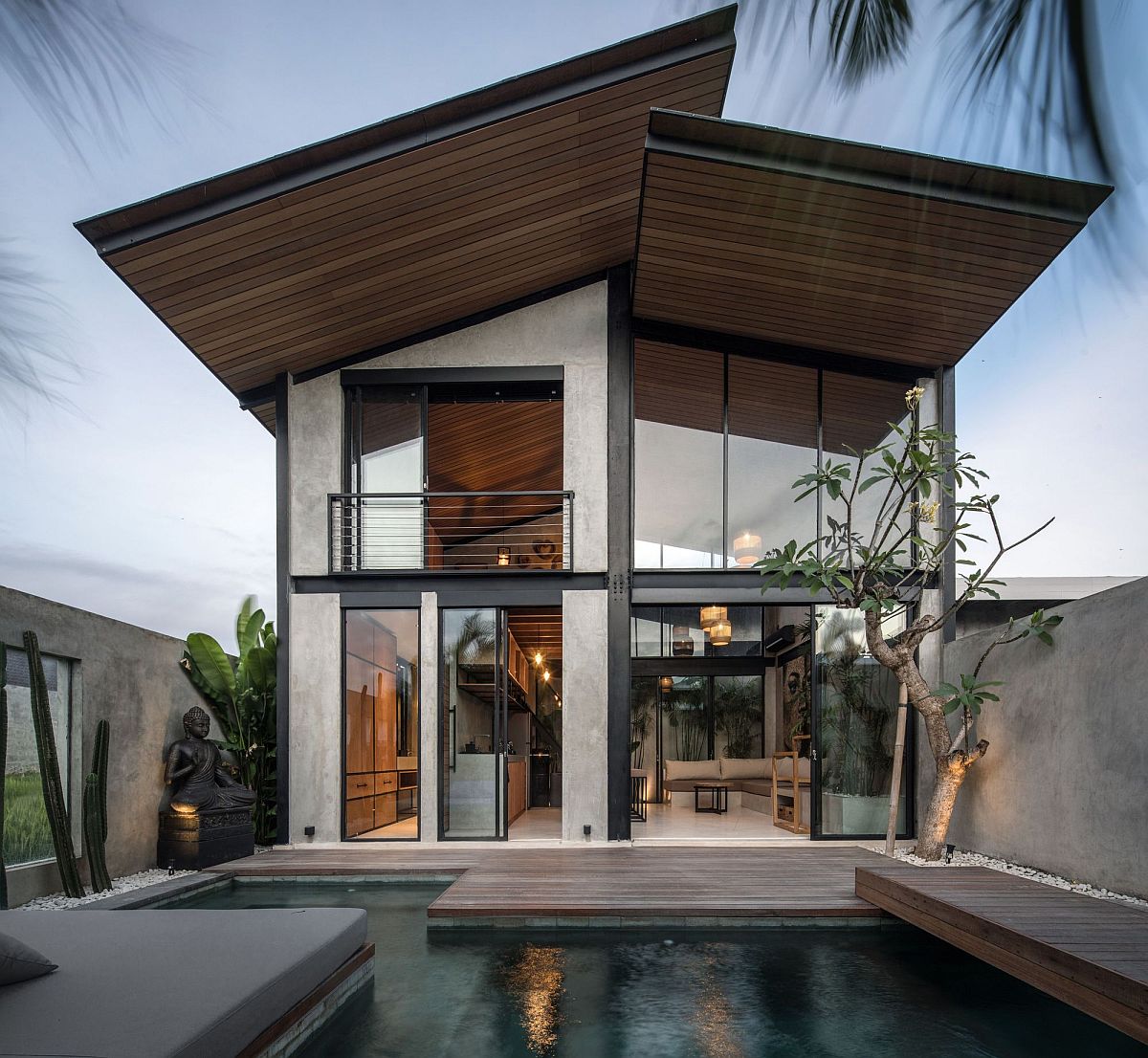
Source: decoist.com
Modern loft houses, a blend of industrial chic and open-plan living, are gaining popularity. This section delves into specific examples, highlighting design elements, and explores the evolution of this architectural style. Understanding the interplay between design choices and the surrounding environment provides valuable insights for future loft house projects.
Notable Modern Loft House Examples
Several modern loft houses stand out for their unique features and innovative designs. These examples showcase the potential of the loft style, demonstrating how creative use of space and materials can create a captivating living experience. For instance, the addition of large windows in a loft house can create a seamless connection to the outdoors, blurring the lines between indoor and outdoor living.
- The “Brooklyn Bridge Loft”: Located in the heart of New York City, this loft embraces industrial aesthetics. Exposed brick walls, high ceilings, and large windows offer stunning city views. The design maximizes natural light, creating a vibrant and spacious interior.
- The “Urban Oasis Loft”: Situated in a vibrant urban area, this loft emphasizes natural light and an open layout. Large windows frame panoramic views, while a strategically placed skylight brings daylight deep into the interior. The loft showcases a seamless transition between living, dining, and kitchen areas.
- The “Coastal Retreat Loft”: Nestled along a scenic coastline, this loft takes advantage of the surrounding environment. Expansive glass walls and large terraces offer breathtaking ocean views. The design cleverly integrates outdoor living spaces, seamlessly blending the indoor and outdoor environments. The materials used, such as polished concrete and sustainable wood, complement the natural beauty of the coastal setting.
Successful Design Elements
Successful modern loft house designs often incorporate specific elements that contribute to their appeal and functionality. These elements are crucial in creating a harmonious blend of form and function. For instance, the thoughtful use of lighting can dramatically impact the mood and atmosphere of a space.
- Open Floor Plans: Open-plan layouts maximize space and create a sense of spaciousness. This is a defining characteristic of modern loft houses, facilitating seamless transitions between living, dining, and cooking areas. The design often promotes a sense of flow and connection throughout the house.
- High Ceilings and Large Windows: These features are crucial for maximizing natural light and creating a sense of grandeur. They also offer expansive views of the surrounding environment, especially in loft houses located in urban or scenic areas.
- Exposed Structural Elements: Exposed brick, concrete, or steel beams add character and an industrial touch to the loft house design. These elements showcase the building’s raw beauty and history, contributing to the unique atmosphere of the space.
History and Evolution of Modern Loft House Architecture
The modern loft house style emerged from the conversion of industrial spaces, such as warehouses and factories, into residential homes. Early loft conversions focused on maximizing space and functionality, with a focus on practicality and industrial aesthetics.
- The initial concept of loft living stemmed from the need to utilize existing industrial spaces in urban environments. The emphasis was often on adaptability and cost-effectiveness, given the need to reuse existing structures.
- Over time, loft designs evolved, incorporating modern design principles and a greater emphasis on aesthetic appeal. The incorporation of contemporary materials and fixtures transformed the industrial aesthetic into a modern, desirable living style.
Environmental Influence on Design
The surrounding environment significantly impacts the design of a modern loft house. The climate, geography, and views all play a critical role in shaping the final design. For example, a loft house situated in a mountainous region will likely differ in design from one located near a beach.
- Climate: In regions with harsh winters, loft houses might incorporate features like insulation and strategically placed windows to maximize heat retention. Conversely, in warmer climates, designs might prioritize ventilation and natural cooling.
- Geography: The topography of the surrounding area can influence the layout and orientation of the loft house. Houses built on hillsides or near bodies of water will require unique design considerations.
- Views: If the surrounding environment offers spectacular views, loft house designs often incorporate large windows and outdoor spaces to maximize these views.
Location and Construction
The chosen location significantly impacts the construction of a modern loft house. Urban locations often necessitate careful planning and consideration of zoning regulations, while rural locations may offer more flexibility.
- Urban Locations: Urban lofts often require navigating complex zoning regulations, building codes, and potentially limited building footprints. Efficient space planning and innovative architectural solutions are crucial in these contexts.
- Rural Locations: Rural locations offer more flexibility in terms of building design and size. However, considerations regarding access to utilities and the overall environmental impact are essential.
Comparison of Modern Loft Houses
| Design | Features | Materials | Location |
|---|---|---|---|
| Brooklyn Bridge Loft | Exposed brick, high ceilings, large windows, open floor plan | Brick, concrete, steel, glass | Urban, New York City |
| Urban Oasis Loft | Large windows, skylights, open layout, natural light maximization | Concrete, glass, steel, wood | Urban, dense city area |
| Coastal Retreat Loft | Expansive glass walls, large terraces, seamless indoor-outdoor flow | Glass, polished concrete, sustainable wood, steel | Coastal, waterfront location |
Technological Integration
Modern loft houses are increasingly incorporating smart home technology to enhance functionality, improve energy efficiency, and streamline daily life. This integration creates a more responsive and personalized living experience, making the home truly a reflection of the resident’s needs and preferences. Smart technology empowers residents to control and manage various aspects of their home, from lighting and temperature to security and entertainment.
Smart Home Technology Enhancements
Smart home technology significantly enhances the functionality of a modern loft house. Automation systems can be programmed to adjust lighting, temperature, and security systems based on schedules or environmental conditions, providing a comfortable and secure living environment. Moreover, integration with voice assistants allows for hands-free control, further streamlining daily tasks and increasing convenience.
Automation in a Modern Loft House
Automation plays a crucial role in modern loft houses, providing a seamless and responsive living experience. Automated systems can control lighting, adjust temperature, and manage security, all triggered by pre-programmed schedules or real-time conditions. For instance, a smart thermostat can automatically adjust the temperature based on occupancy and external weather, optimizing energy use and comfort.
Smart Home Devices for Modern Loft Houses
A wide range of smart home devices can be incorporated into a modern loft house, enhancing its functionality and convenience. Smart lighting systems allow for personalized lighting schemes and energy-saving features. Smart thermostats automatically adjust temperature settings for optimal comfort and energy efficiency. Smart security systems offer enhanced protection and remote monitoring capabilities. Smart speakers facilitate voice control over various home functions, such as adjusting music volume, controlling lights, or setting alarms.
- Smart thermostats (e.g., Nest, Ecobee) automatically adjust temperature based on occupancy and external conditions, saving energy and improving comfort.
- Smart lighting systems (e.g., Philips Hue) offer personalized lighting schemes and energy-saving features.
- Smart security systems (e.g., Ring, Arlo) provide enhanced protection and remote monitoring.
- Smart speakers (e.g., Amazon Echo, Google Home) facilitate voice control over various home functions.
- Smart appliances (e.g., smart refrigerators, smart ovens) can enhance convenience and provide data insights.
Improving Energy Efficiency
Smart home technology significantly improves energy efficiency in modern loft houses. Smart thermostats, for example, can automatically adjust temperature settings based on occupancy and external conditions, reducing energy waste. Smart lighting systems can be programmed to turn off lights when not in use, further reducing energy consumption. By integrating energy monitoring systems, residents can gain insights into their energy usage patterns and make informed decisions to optimize their energy consumption.
This can lead to substantial cost savings over time.
Designing a Smart Home System
A comprehensive smart home system for a modern loft house should be designed with user needs and preferences in mind. A central hub, such as a smart speaker or a dedicated smart home control panel, acts as the command center for controlling various devices. The system should integrate seamlessly with existing home infrastructure, minimizing disruptions and maximizing functionality.
A well-designed system should allow for future expansion and upgrades, accommodating new technologies as they emerge. It’s important to carefully consider security protocols and data privacy to ensure the safety and confidentiality of personal information.
Smart Home Integrations Table
| System | Devices | Benefits | Cost |
|---|---|---|---|
| Lighting | Smart bulbs, smart switches | Personalized lighting schemes, energy savings, remote control | Variable, depending on the number and type of devices |
| Temperature Control | Smart thermostats | Optimized energy use, customized comfort levels, remote control | Variable, depending on features and brand |
| Security | Smart doorbells, security cameras, motion sensors | Enhanced protection, remote monitoring, real-time alerts | Variable, depending on the sophistication and coverage area |
| Entertainment | Smart speakers, smart TVs | Voice control, seamless integration with other systems | Variable, depending on features and brand |
Closing Notes
In conclusion, a modern loft house offers a distinctive living experience that blends style, functionality, and a touch of modern innovation. We’ve covered everything from the architectural and design aspects to the practical considerations of living in such a home. Ultimately, whether a modern loft house is the right fit depends on individual needs and preferences. Hopefully, this guide has provided valuable insights for those considering this unique and stylish housing option.
FAQ Guide
What are some common challenges of living in a modern loft house?
Modern loft houses, while stylish, can sometimes present challenges related to space optimization, maintaining a cozy atmosphere, and potential issues with noise control. Effective storage solutions and soundproofing strategies are crucial to mitigate these challenges.
How do you maximize natural light in a modern loft house?
Maximizing natural light is key to a bright and airy loft. Strategically placed windows, skylights, and reflective surfaces can dramatically enhance the space. Choosing light-colored walls and flooring further amplifies the effect.
What are some sustainable building materials suitable for modern loft houses?
Sustainable materials like reclaimed wood, bamboo, and recycled glass are great options for eco-conscious loft construction. These materials often offer unique aesthetic appeal while minimizing environmental impact.
What are the advantages of a modern loft house compared to a traditional one?
Modern lofts often offer more open space and flexibility, along with better integration of modern technology and sustainable design. Traditional houses might be more structured but lack the dynamic feel of a modern loft.
- Pivot Glass Doors A Stylish Choice - June 2, 2025
- Mountain Modern Cabin A Stylish Retreat - May 6, 2025
- Modern Loft House A Stylish Home - May 6, 2025

